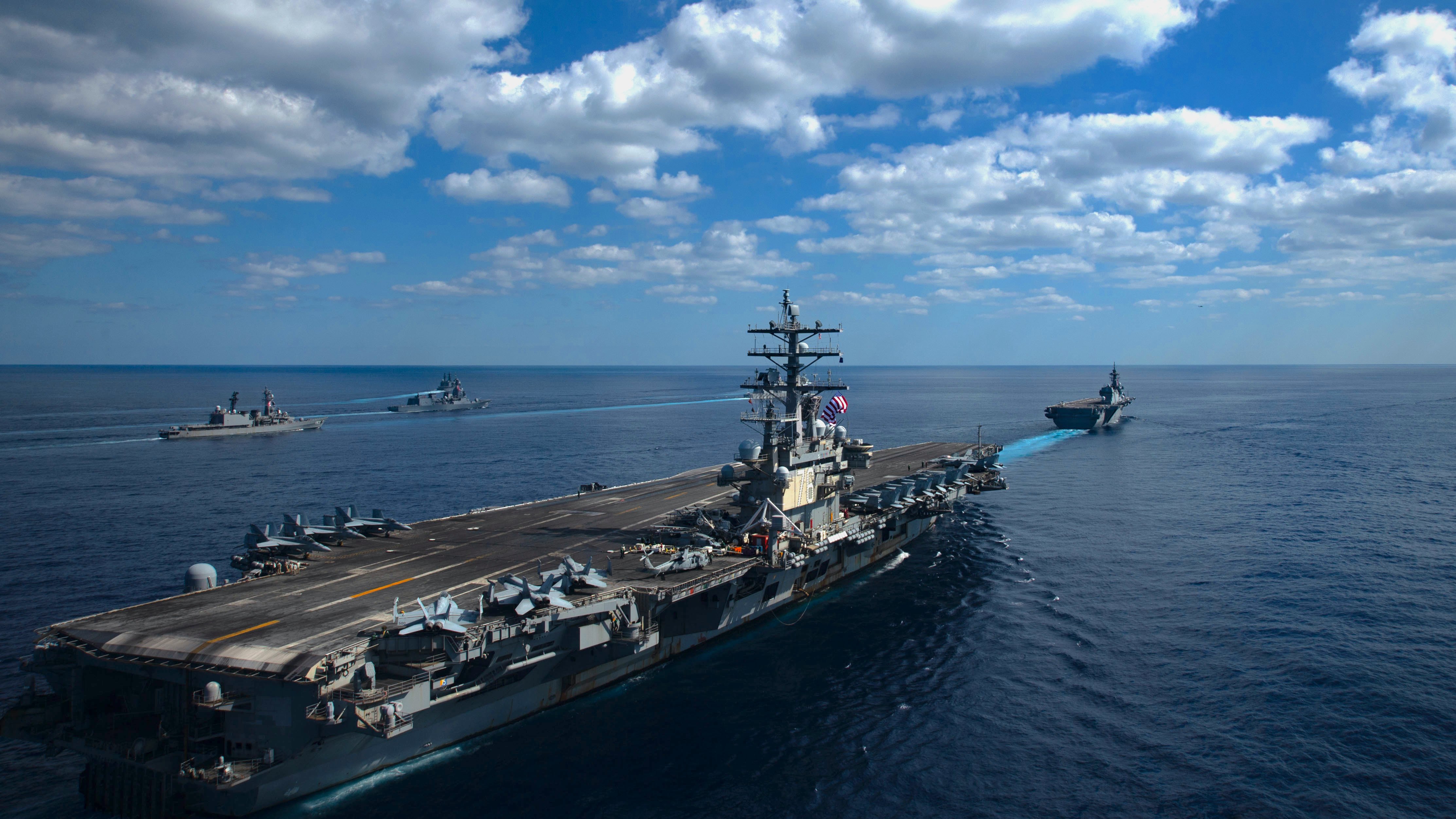
These are the approximate positions of the U.S. Navy’s deployed carrier strike groups and amphibious ready groups throughout the world as of Nov. 2, 2020, based on Navy and public data. In cases where a CSG or ARG is conducting disaggregated operations, the chart reflects the location of the capital ship. This post has been updated.
Total U.S. Navy Battle Force:
296
Ships Underway
| Deployed Ships Underway | Non-deployed Ships Underway | Total Ships Underway |
| 51 | 24 | 75 |
Ships Deployed by Fleet
| Fleet Forces | 3rd Fleet | 4th Fleet | 5th Fleet | 6th Fleet | 7th Fleet | Total |
| 1 | 0 | 4 | 21 | 14 | 55 | 95 |
In the Philippine Sea
The Ronald Reagan Carrier Strike Group (CSG) is operating in the Philippine Sea.
U.S. Indo-Pacific Command forces and units from the Japan Self-Defense Force are continuing exercise Keen Sword 21 (KS21) on military installations throughout mainland Japan and Okinawa, according to a U.S. Navy release. An estimated 9,000 personnel and 100 aircraft from the U.S. Navy, Air Force, Army, and Marine Corps are participating, including the Ronald Reagan Carrier Strike Group and Carrier Air Wing (CVW) 5, USS Ashland (LSD-48), HMCS Winnipeg (FFH-338), Commander Task Force 72 and 5th Air Force.
The exercise started October 26 and is slated to continue through Nov. 5.
Carrier Strike Group 5

Yokosuka-based CSG 5 commands the Reagan Strike Group and is embarked on the carrier.
Aircraft carrier
USS Ronald Reagan (CVN-76), homeported in Yokosuka, Japan.
Carrier Air Wing 5

Carrier Air Wing (CVW) 5, based at Marine Corps Air Station Iwakuni, Japan, is embarked aboard Ronald Reagan and includes a total of nine squadrons and detachments:
- The “Royal Maces” of Strike Fighter Squadron (VFA) 27 from Marine Corps Air Station Iwakuni
- The “Diamondbacks” of VFA-102 from Marine Corps Air Station Iwakuni
- The “Eagles” of VFA-115 from Marine Corps Air Station Iwakuni
- The “Dambusters” of VFA-195 from Marine Corps Air Station Iwakuni
- The “Shadowhawks” of Electronic Attack Squadron (VAQ) 141 Marine Corps Air Station Iwakuni
- The “Tigertails” of Carrier Airborne Early Warning Squadron (VAW) 125 from Marine Corps Air Station Iwakuni
- The “Providers” of Fleet Logistics Support Squadron (VRC) 30 Det 5 from Marine Corps Air Station Iwakuni
- The “Golden Falcons” of Helicopter Sea Combat Squadron (HSC) 12 from Naval Facility Atsugi, Japan
- The “Saberhawks” of Helicopter Maritime Strike Squadron (HSM) 77 from Naval Air Facility Atsugi
Cruiser
USS Antietam (CG-54), homeported in Yokosuka.
Destroyer Squadron 15

Destroyer Squadron 15 is based in Yokosuka, Japan, and the staff is embarked on the carrier. U.S. 7th Fleet has not fully specified the escorts accompanying Reagan on its patrol, but the CSG includes:
- USS Mustin (DDG-89), homeported in Yokosuka.
- USS John McCain (DDG-89), homeported in Yokosuka.
In the Persian Gulf

USS Nimitz (CVN-68) and the Nimitz Carrier Strike Group are underway in the Central Persian Gulf.
Carrier Strike Group 11

San Diego-based CSG 11 commands the Nimitz CSG and is embarked on the carrier.
Aircraft carrier
USS Nimitz (CVN-68), homeported in Bremerton, Wash.
Carrier Air Wing 17

Carrier Air Wing 17, based at Naval Air Station Lemoore, Calif., is embarked on Nimitz and includes a total of nine squadrons and detachments:
- The “Redcocks” of VFA 22 – Strike Fighter Squadron (VFA) F/A-18F Super Hornet – from Naval Air Station Lemoore, Calif.
- The “Kestrels” of VFA137 F/A-18 E – from Naval Air Station Lemoore, Calif.
- The “Mighty Shrike” of VFA 94 F/A-18F – from Naval Air Station Lemoore, Calif.
- The “Death Rattlers” of VMFA-323 F/A-18C – from Marine Corps Air Station Miramar San Diego, Calif.
- The “Cougars” of VAQ-139 – Electronic Attack Squadron (VAQ) EA-18G Growlers – from Naval Air Station Whidbey Island – Wash.
- The “Sun Kings” of VAW-116 –Carrier Airborne Early Warning Squadron (VAW) E2C Hawkeye – from Naval Air Station Point Mugu, Calif.
- The “Providers” of VRC-30 – Detachment – Fleet Logistics Support Squadron (VRC) C-2 – from Naval Air Station North Island, Calif.
- The “Screamin’ Indians” of HSC-6 – Helicopter Sea Combat Squadron (HSC) MH-60S– from Naval Air Station North Island, Calif.
- The “Battlecats” of HSM-73 – Helicopter Maritime Strike Squadron (HSM) MH-60R – from Naval Air Station North Island, Calif.
Cruiser
USS Princeton (CG-59), homeported in San Diego, Calif.
Destroyer Squadron 9

Destroyer Squadron 9 is based at Naval Station Everett, Wash. The DESRON commodore and staff are embarked on Nimitz.
- USS John Paul Jones (DDG-53), homeported in Pearl Harbor, Hawaii
- USS Sterett (DDG-104), homeported in San Diego, Calif.
- USS Ralph Johnson (DDG-114), homeported in Everett, Wash.
In the Eastern Pacific

USS Makin Island (LHD-8) is underway in the Southern California Operating Areas with the 15th Marine Expeditionary Unit (MEU) embarked.
USS Essex (LHD-2) is underway in the Southern California Operating Areas.
In the Western Atlantic

The Iwo Jima Amphibious Ready Group (ARG) is underway in the Virginia Capes Operating Areas.

USS Gerald R. Ford (CVN-78) is conducting carrier qualifications for fleet replacement squadron aviators while underway in the Virginia Capes Operating Areas. The mission of the FRS is to train pilots, naval flight officers and maintainers on their assigned aircraft types. Some pilots may be training for current and upcoming deployments, where they will relieve currently-deployed pilots serving in fleet squadrons. The qualifications include both day and night flight operations. In order for FRS pilots to qualify and advance into a fleet squadron, the pilot must successfully complete two daytime touch-and-gos with 10 daytime landings, and two touch-and-gos with six nighttime landings on an aircraft carrier.
In addition to these major formations, not shown are thousands of others serving in submarines, individual surface ships, aircraft squadrons, SEALs, Special Purpose Marine Air-Ground Task Forces, Seabees, Coast Guard cutters, EOD Mobile Units, and more serving throughout the globe.





